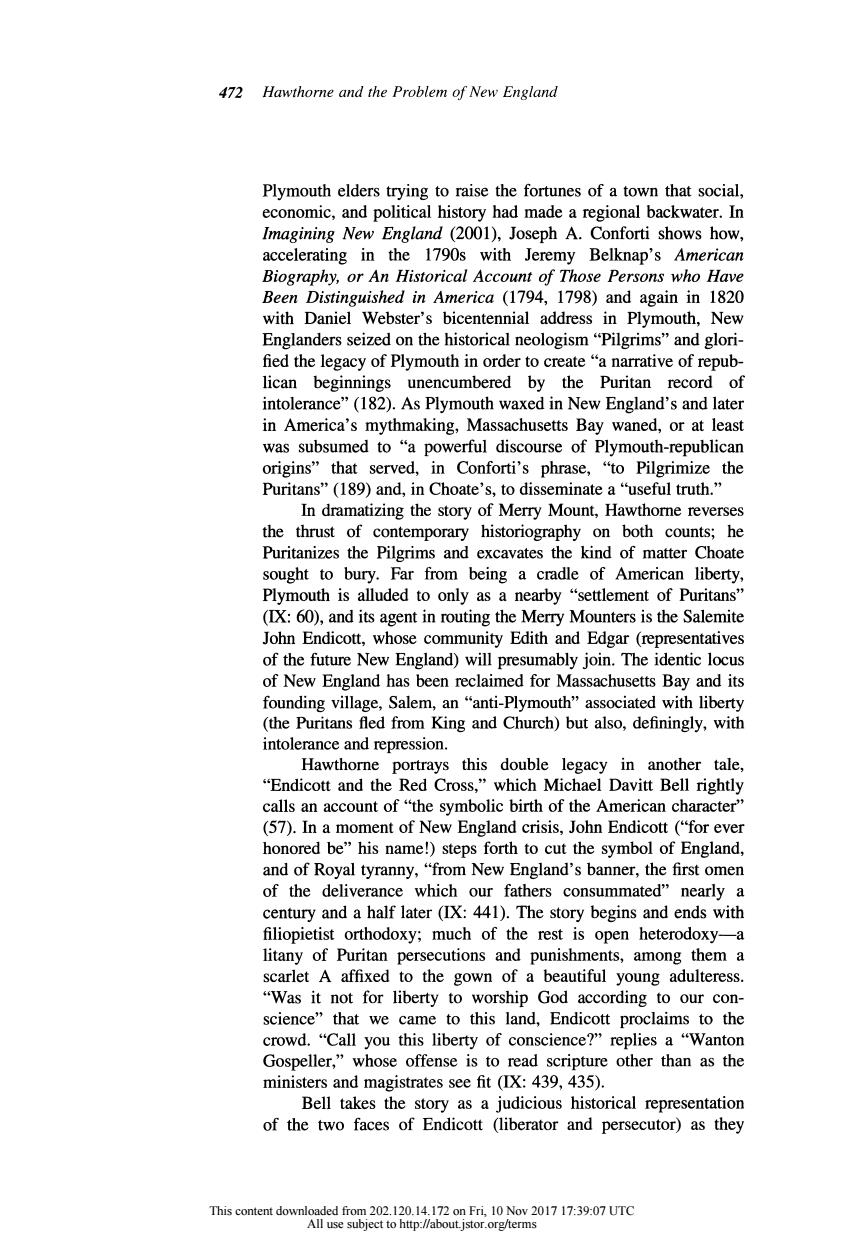正在加载图片...

472 Hawthorne and the Problem of New England Plymouth elders trying to raise the fortunes of a town that social, economic,and political history had made a regional backwater.In Imagining New England (2001),Joseph A.Conforti shows how, accelerating in the 1790s with Jeremy Belknap's American Biography,or An Historical Account of Those Persons who Have Been Distinguished in America (1794,1798)and again in 1820 with Daniel Webster's bicentennial address in Plymouth,New Englanders seized on the historical neologism "Pilgrims"and glori- fied the legacy of Plymouth in order to create"a narrative of repub- lican beginnings unencumbered by the Puritan record of intolerance"(182).As Plymouth waxed in New England's and later in America's mythmaking,Massachusetts Bay waned,or at least was subsumed to "a powerful discourse of Plymouth-republican origins"that served,in Conforti's phrase,"to Pilgrimize the Puritans”(l89)and,in Choate's,to disseminate a“useful truth.” In dramatizing the story of Merry Mount,Hawthorne reverses the thrust of contemporary historiography on both counts;he Puritanizes the Pilgrims and excavates the kind of matter Choate sought to bury.Far from being a cradle of American liberty, Plymouth is alluded to only as a nearby "settlement of Puritans" (IX:60),and its agent in routing the Merry Mounters is the Salemite John Endicott,whose community Edith and Edgar(representatives of the future New England)will presumably join.The identic locus of New England has been reclaimed for Massachusetts Bay and its founding village,Salem,an "anti-Plymouth"associated with liberty (the Puritans fled from King and Church)but also,definingly,with intolerance and repression. Hawthorne portrays this double legacy in another tale, "Endicott and the Red Cross,"which Michael Davitt Bell rightly calls an account of"the symbolic birth of the American character" (57).In a moment of New England crisis,John Endicott ("for ever honored be"his name!)steps forth to cut the symbol of England, and of Royal tyranny,"from New England's banner,the first omen of the deliverance which our fathers consummated"nearly a century and a half later (IX:441).The story begins and ends with filiopietist orthodoxy;much of the rest is open heterodoxy-a litany of Puritan persecutions and punishments,among them a scarlet A affixed to the gown of a beautiful young adulteress. "Was it not for liberty to worship God according to our con- science"that we came to this land,Endicott proclaims to the crowd.“Call you this liberty of conscience?”replies a“Wanton Gospeller,"whose offense is to read scripture other than as the ministers and magistrates see fit (IX:439,435). Bell takes the story as a judicious historical representation of the two faces of Endicott (liberator and persecutor)as they This content downloaded from 202.120.14.172 on Fri,10 Nov 2017 17:39:07 UTC All use subject to http://about.jstor.org/terms472 Hawthorne and the Problem of New England Plymouth elders trying to raise the fortunes of a town that social, economic, and political history had made a regional backwater. In Imagining New England (2001), Joseph A. Conforti shows how, accelerating in the 1790s with Jeremy Belknap's American Biography y or An Historical Account of Those Persons who Have Been Distinguished in America (1794, 1798) and again in 1820 with Daniel Webster's bicentennial address in Plymouth, New Englanders seized on the historical neologism "Pilgrims" and glori fied the legacy of Plymouth in order to create "a narrative of repub lican beginnings unencumbered by the Puritan record of intolerance" (182). As Plymouth waxed in New England's and later in America's mythmaking, Massachusetts Bay waned, or at least was subsumed to "a powerful discourse of Plymouth-republican origins" that served, in Conforti's phrase, "to Pilgrimize the Puritans" (189) and, in Choate's, to disseminate a "useful truth." In dramatizing the story of Merry Mount, Hawthorne reverses the thrust of contemporary historiography on both counts; he Puritanizes the Pilgrims and excavates the kind of matter Choate sought to bury. Far from being a cradle of American liberty, Plymouth is alluded to only as a nearby "settlement of Puritans" (DC: 60), and its agent in routing the Merry Mounters is the Salemite John Endicott, whose community Edith and Edgar (representatives of the future New England) will presumably join. The identic locus of New England has been reclaimed for Massachusetts Bay and its founding village, Salem, an "anti-Plymouth" associated with liberty (the Puritans fled from King and Church) but also, definingly, with intolerance and repression. Hawthorne portrays this double legacy in another tale, "Endicott and the Red Cross," which Michael Davitt Bell rightly calls an account of "the symbolic birth of the American character" (57). In a moment of New England crisis, John Endicott ("for ever honored be" his name!) steps forth to cut the symbol of England, and of Royal tyranny, "from New England's banner, the first omen of the deliverance which our fathers consummated" nearly a century and a half later (IX: 441). The story begins and ends with filiopietist orthodoxy; much of the rest is open heterodoxy?a litany of Puritan persecutions and punishments, among them a scarlet A affixed to the gown of a beautiful young adulteress. "Was it not for liberty to worship God according to our con science" that we came to this land, Endicott proclaims to the crowd. "Call you this liberty of conscience?" replies a "Wanton Gospeller," whose offense is to read scripture other than as the ministers and magistrates see fit (IX: 439, 435). Bell takes the story as a judicious historical representation of the two faces of Endicott (liberator and persecutor) as they This content downloaded from 202.120.14.172 on Fri, 10 Nov 2017 17:39:07 UTC All use subject to http://about.jstor.org/terms